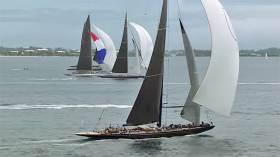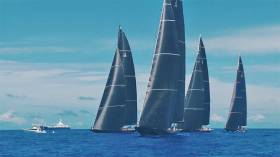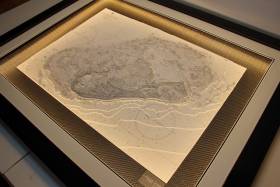Displaying items by tag: J Class
#AmericasCup - Lionheart sailed to the top place in the J Class in yesterday’s final round of the America’s Cup Superyacht Regatta in Bermuda.
The team behind the Dutch yacht – which features Volvo Ocean Race veteran Bouwe Bekking as its longtime tactician – saw their consistent performance over the three days put them in good stead.
They will look to redouble their efforts next week to take home a specially commissioned relief map of Bermuda handcrafted by Latitude Kinsale, as previously reported on Afloat.ie.
Update 20/6: An earlier version of this post incorrectly stated that the J Class Prize was being contested in the Superyacht Regatta; instead, the J Class have their own regatta which began on Monday 19 June.
#AmericasCup - Hanuman rebounded from a false start to claim victory in the first round of the America’s Cup Superyacht Regatta in Bermuda yesterday (Tuesday 13 June).
Optimised for expected light conditions, the J Class fleet leader was quick despite the patchy breeze of 5-9 knots, catching up with classmate Velsheda after the first windward mark when their kite-setting failed, and passing Ranger to take the line.
Topaz, who also started near the committee boat with Velsheda and Hanuman, slipped down to fifth, while Lionheart overcame early struggles to place fourth.
All five yachts — plus Svea, expected to join the fleet today (Wednesday 14 June) — will be competing for their own J Class prizes next week, represented by exquisitely detailed 3D maps of Bermuda commissioned from relief chart specialists Latitude Kinsale.
Racing for the J Class among the larger superyacht fleet continues this afternoon with round two, and concludes with the third and final round tomorrow (Thursday 15 June).
In other news from Bermuda, Land Rover BAR Academy placed second in the final standings of the Pool B qualifiers in the Red Bull Youth America’s Cup.
The handpicked team now have a few days to prepare before the final series races from Tuesday 20 to Wednesday 21 June.
Update 20/6: An earlier version of this post incorrectly stated that the J Class Prize was being contested in the Superyacht Regatta; instead, the J Class have their own regatta which began on Monday 19 June.
#AmericasCup - Relief chart specialists Latitude Kinsale have been commissioned to create the winners' trophies for the America’s Cup J Class Regatta in Bermuda this month.
Renowned artist Bobby Nash, based in Kinsale in West Cork, created unique 3D charts based on the classic Bermuda Islands map from the UKHO Admiralty archive for the first, second and third prizes in the exclusive regatta for traditional America’s Cup J Class yachts.
The 1950s-era chart shows the archipelago of islands and reefs that comprise the British Overseas Territory in the North Atlantic — the complex structure painstakingly crafted by hand from as many as 2,000 individual pieces.
All three prizes are presented in frames incorporating patent-pending Surround Lighting for optimum illumination of their meticulous details.
“It’s a great honour to be selected as the creator of the overall prizes for the America’s Cup J-Class regatta in Bermuda,” said Bobby Nash. “To have my work appreciated by such a prestigious event and organisation is a reflection of 15 years of experience, design evolution and presentation.”
Latitude Kinsale is renowned worldwide for its soughtt-after 3D charts, framed lighting charts, relief nautical bespoke chart tables and commissions, creating a unique way to appreciate the beauty of the coastline and the sea.
J Class Joins International Maxi Association to Gain Its First World Championship
Just over one hundred years on from the advent of the Universal Rule, to which they were originally built, the J Class will this year get to race its first ever World Championship.
The J Class Association has recently become an affiliate member of the International Maxi Association (IMA). The IMA administers the International Maxi Class, recognised by the sport’s governing body, World Sailing. This status permits the IMA to stage annual World Championships for maxi boats, notably the Maxi 72 World Championship, held every September in Porto Cervo, Sardinia and now it's second, the J Class World Championship.
For the magnificent Js, their first World Championship will conclude a heavily America’s Cup-orientated 2017 season, following the America’s Cup Superyacht Regatta and the America’s Cup J Class Regatta. Both will be held in Bermuda in June, the latter coinciding with the first two days of the 35th America’s Cup.
From Bermuda, the world’s most magnificent sailing yachts, famous for their slender lines and extreme 40ft long overhangs, will return to their spiritual home of Newport, Rhode Island on the US East Coast. Here at the J Class World Championship over 21-26th August, the boats will once again get to compete on the same waters as they did in their heyday in the 1930s when American yachts, led by the likes of Harold S. Vanderbilt, of the US railroad dynasty, mounted successful defences against strong British challenges from grocery chain and tea magnate Sir Thomas Lipton and aviation pioneer Sir Tom Sopwith.
This landmark year for the Js coincides with the class having never been stronger, J Class Association secretary Louise Morton observes: "With the launch of Svea/JS1 last month, the J Class fleet now has nine yachts afloat - the largest number in our history. As the JCA continues to grow and welcome new launches to the fleet, we are really excited to be holding our first J Class World Championship in Newport this summer.
“Hosted by New York Yacht Club in collaboration with the JCA and the IMA, at least six Js are expected to grace the start line at this inaugural edition. We have long enjoyed a positive racing relationship with IMA members and are delighted now to be part of its supportive, global community.”
Already signed up for the event are Velsheda, Ranger, Lionheart, Svea, Hanuman and Topaz, which will be based in Newport Shipyard.
The J Class is the latest in the ever-expanding International Maxi Association, that also has the Maxi 72 grand prix racers and the stylish Wally class as affiliate members.
IMA Secretary General Andrew McIrvine, who spent nearly two years bringing the relationship with the J Class Association to fruition, commented: "We are delighted with our new affiliation with the JCA. It is a project we worked hard on, and seeing it finalised is deeply satisfying. The IMA’s two World Championships for 2017 will therefore be for the Maxi 72s in Porto Cervo, and the other for these iconic vessels in August off Newport, Rhode Island. Because of this affiliation, as many as six J Class owners are becoming IMA members. It will also further our partnership with the New York Yacht Club following on from the Maxi 72 North American Championship which we held in Newport in conjunction with the NYYC last year. To return a year later with the J Class is a great achievement.”
Following his club’s lengthy association with the America’s Cup, New York Yacht Club Commodore Philip A. Lotz added: "It makes perfect sense for the J Class to return to its spiritual home in Newport to contest its first World Championship, and the New York Yacht Club, at Harbour Court, is extremely proud to host this historic International Maxi Association World Championship. Nearly three decades ago, the duel between Shamrock and Endeavour on Narragansett Bay captivated the sailing world. We anticipate this event to generate a similar, if not more enthusiastic, response, and we’re excited to play our part.”
Superyacht Fleet Expected to Visit London Olympics then Ireland
London is expected to provide a great SuperYacht venue for the Olympics and the hope is that some of the massive visitors may in turn continue cruising in Ireland according to www.YachtsLondon.com who are providing services to help yachts arrange to visit in 2012.
There are only a handful of capital cities that can accommodate SuperYachts in their hearts and London is one of these with its iconic river views of Tower Bridge, Greenwich, the O2 Dome and the Canary Wharf financial district.
A legacy of London's place at the centre of world trade in the past are its remaining docks which will provide high quality stern-to mooring for 50-100 large yachts as demand warrants. Canary Wharf will be the centre of this with added space in the Royal Docks next to City Airport. Yachts up to 200m LOA and 30m beam can be accommodated.
Hugh Agnew, one of the principals of YachtsLondon said that "many parties will be involved including dock owners, landowners, pier operators, PLA, MCA, security and suppliers. We can help with all of these, but the key at the moment is early decisions so that sufficient dock space is put in place for 2012."
As well as the Olympic Games there are many other events in the UK in 2012 including Superyacht Cup, J Class regattas, Westward Cup so if there was ever a year to plan to make UK the destination then 2012 will be it with the possibility to link to cruising in Ireland, Scotland and Scandinavia.

































































